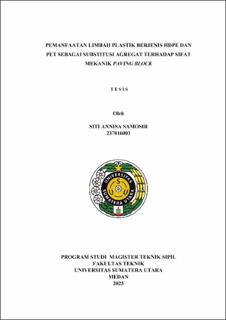| dc.description.abstract | Waste is a serious issue for the environment, health, and the economy. Plastic, in particular, is a major contributor. From 1950 to 2018, global plastic production reached over 8 billion tons, with plastic bottles being one of the main contributors. To address the accumulation of plastic bottle waste, one innovative solution is to utilize it in construction products.This study investigates the effects of HDPE (High-Density Polyethylene) and PET (Polyethylene Terephthalate) plastic waste as aggregate substitutes in paving blocks on mechanical properties, durability, cost, and surface morphology. Compressive strength tests showed that the control paving block (25.38 MPa). The addition of plastic waste reduced performance, with the optimal compressive strength found in 5% HDPE (21.24 MPa) and 5% PET (22.32 MPa), while the lowest was at 15% HDPE (14.62 MPa). The highest water absorption (1.36%) occurred in 5% HDPE, while the lowest was in 15% PET. An increase in plastic content reduced water absorption due to the hydrophobic nature of plastic.In the sodium sulfate resistance test, the weight difference between the control paving block and those with plastic additions was ≤1% after five soaking cycles, with no visible or structural cracks or defects. The impact test showed the best performance at 5% plastic content (withstood up to 10 blows), while the 15% plastic variation only withstood 5 blows. Scanning Electron Microscopy (SEM) results showed that paving blocks with plastic substitution had few voids, but the plastic–aggregate bond was weak due to the smooth surface and differences in chemical properties. Economically, using plastic waste as an aggregate substitute in paving blocks reduced material costs by 1.78% and plastic waste by 7.35 kg/m². Although plastic–aggregate adhesion still needs optimization, test results indicate that plastic waste has the potential to serve as an environmentally friendly alternative material with adequate performance for sustainable paving block applications. | en_US |


